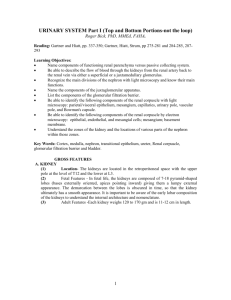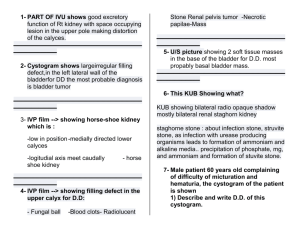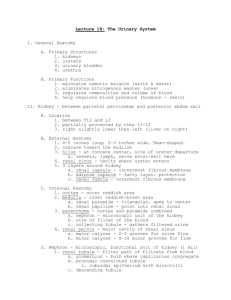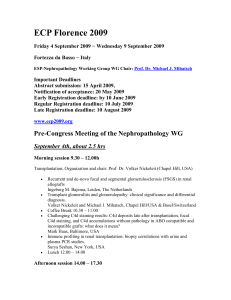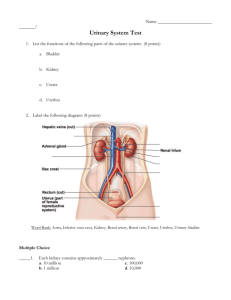URINARY SYSTEM I
advertisement
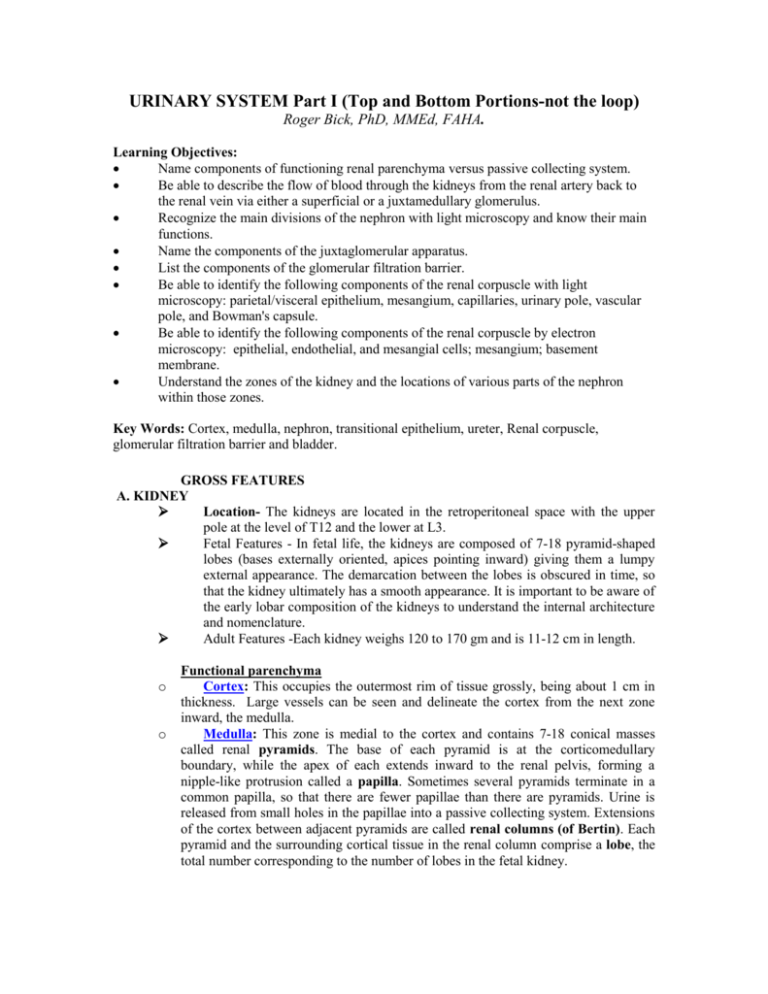
URINARY SYSTEM Part I (Top and Bottom Portions-not the loop) Roger Bick, PhD, MMEd, FAHA. Learning Objectives: Name components of functioning renal parenchyma versus passive collecting system. Be able to describe the flow of blood through the kidneys from the renal artery back to the renal vein via either a superficial or a juxtamedullary glomerulus. Recognize the main divisions of the nephron with light microscopy and know their main functions. Name the components of the juxtaglomerular apparatus. List the components of the glomerular filtration barrier. Be able to identify the following components of the renal corpuscle with light microscopy: parietal/visceral epithelium, mesangium, capillaries, urinary pole, vascular pole, and Bowman's capsule. Be able to identify the following components of the renal corpuscle by electron microscopy: epithelial, endothelial, and mesangial cells; mesangium; basement membrane. Understand the zones of the kidney and the locations of various parts of the nephron within those zones. Key Words: Cortex, medulla, nephron, transitional epithelium, ureter, Renal corpuscle, glomerular filtration barrier and bladder. GROSS FEATURES A. KIDNEY Location- The kidneys are located in the retroperitoneal space with the upper pole at the level of T12 and the lower at L3. Fetal Features - In fetal life, the kidneys are composed of 7-18 pyramid-shaped lobes (bases externally oriented, apices pointing inward) giving them a lumpy external appearance. The demarcation between the lobes is obscured in time, so that the kidney ultimately has a smooth appearance. It is important to be aware of the early lobar composition of the kidneys to understand the internal architecture and nomenclature. Adult Features -Each kidney weighs 120 to 170 gm and is 11-12 cm in length. o o Functional parenchyma Cortex: This occupies the outermost rim of tissue grossly, being about 1 cm in thickness. Large vessels can be seen and delineate the cortex from the next zone inward, the medulla. Medulla: This zone is medial to the cortex and contains 7-18 conical masses called renal pyramids. The base of each pyramid is at the corticomedullary boundary, while the apex of each extends inward to the renal pelvis, forming a nipple-like protrusion called a papilla. Sometimes several pyramids terminate in a common papilla, so that there are fewer papillae than there are pyramids. Urine is released from small holes in the papillae into a passive collecting system. Extensions of the cortex between adjacent pyramids are called renal columns (of Bertin). Each pyramid and the surrounding cortical tissue in the renal column comprise a lobe, the total number corresponding to the number of lobes in the fetal kidney. B. Intrarenal (In the kidney) Collecting System Minor Calyx: Each minor calyx is a cup-like structure that surrounds 1-2 papillae and collects the released urine. Major Calyx: The minor calyces funnel into 2-3 larger major calyces. Pelvis: The major calyces funnel into this large atrium-like area deep within the kidney. C. EXTRARENAL COLLECTING SYSTEM Ureter: The pelvis gradually narrows into this tube-like conduit which runs from the kidney to the bladder. The proximal part of the ureter begins in the renal hilum, defined as the medial aspect of the kidney where the renal artery and vein, ureter, and fat are found. Bladder Urethra ARTERIAL SYSTEM – This is important Blood enters the kidney at the hilus via a renal artery, branches into interlobar arteries perpendicular to the surface, between the renal lobes and from these, arcuate arteries branch off at right angles, running parallel to the surface between the cortex and medulla. (Arcuates are very useful landmarks since they define the border between cortex and medulla.) Smaller branches are then given off into the cortex, again running perpendicular to the surface, called interlobular arteries. Circulation distal to these arteries will be considered with other histologic features. Into kidney with interlobar artery, turn right angles at arcuate arteriols, another right angle upwards with interlobular arteriole. Back with veins INNERVATION The kidney is richly supplied with sympathetic nerves that follow the course of the renal arteries and arterioles and innervate the smooth muscle in their walls to contract. Strong sympathetic stimulation constricts these vessels, increasing their resistance and decreasing renal blood flow. Sympathetic nerves are also found on tubules and can directly cause increases in sodium absorption. HISTOLOGIC FEATURES A. COLLECTING SYSTEM 1. Minor Calyx to Bladder; Major and minor calyces have the same basic structure, renal pelvis, ureter and bladder have the same basic histologic structure. a. Mucosa (1) Epithelium is Transitional and increases from 3 cell layers deep at the minor calyx to 6 in the bladder Good marker) (2) Lamina Propria: Loose to dense connective tissue. NOTE: More than 90% of urinary bladder tumors originate in the epithelial lining. b. Muscularis Begins with the minor calyces, and consists of 2 layers of smooth muscle, with the innermost being longitudinal and the external being circular (opposite of GI). As the ureter approaches the bladder, a third outer longitudinal layer is added, which remains over the bladder. c. Adventitia or Serosa Only the dome of the bladder is covered by serosa (peritoneum). The wall of the rest of the bladder and the ureter blend into the surrounding tissues without a defined serosa. 2. Transitional Epithelium Dynamics; The epithelium is unique as it has to be able to expand and contract rapidly. This is accomplished by discoid vesicles in the apical cytoplasm, the membranes serving as reservoirs for membrane expansion. When the bladder is empty (A), the apical cytoplasm of the innermost cells is filled with discoid vesicles underneath the plasmalemma, but as the bladder fills and the epithelium stretches (B), the vesicles fuse with the apical membranes, providing increased surface area. Compare the structure of the transitional epithelium when the urinary bladder is empty (A) or full (B). When the bladder is full, the capacity of epithelial cells to slide upon one another reduces the thickness of the epithelium. As a result, the interior surface of the bladder increases. In B, note the thin strands of collagen fibers separating bundles of smooth muscle cells. 3. Urethra Near the bladder, the urethra has transitional epithelium. Adjacent to the "external world", the epithelium is stratified squamous. Between the zones, the epithelium may be stratified columnar or pseudostratified columnar. The female urethra is mostly stratified squamous epithelium. There are abundant elastic fibers in the lamina propria, and the muscularis consists proximally of inner longitudinal and outer circular smooth muscle. At the urogenital diaphragm, voluntary striated muscle fibers are mixed with the outer layer of smooth muscle. Beyond this, the muscularis begins to disappear and ceases to exist as one of the layers. In the female, the connective tissue, of the adventitia fuses with the vaginal canal. More details regarding the male urethra will be provided in a later lecture. THE RENAL CORPUSCLE (Malpighian Corpuscle) 1. Structure This is a complex structure which absolutely requires both a two and three dimensional conceptualization for complete understanding. The adult glomeruli measure approximately 200 µm in diameter. a. Vascular Component - The Glomerulus (plural: glomeruli) We left the circulation at the level of the small cortical interlobular arteries. Branching off of these are afferent arterioles, with each arteriole subdividing into a convolution of capillaries (Imagine a ball of wool). Each ball of capillaries is a glomerulus and the capillaries merge back into a single efferent arteriole that carries blood away. Where the blood goes from there will be in lecture II. There are cells within the walls of the afferent and efferent arterioles that contain renin, called juxtaglomerular cells, and they are modified smooth muscle cells. The glomerular capillaries have an inner simple squamous fenestrated endothelium in which there are no diaphragms across the fenestrae, so they are very leaky and present little barrier to the movement of plasma. The endothelial cells rest on a glomerular basement membrane (GBM), an amorphous extracellular, gel-like layer, and is thought to be the major barrier to the movement of plasma. a. Glomerular basement membrane (GBM) Major components of the GBM include Type IV collagen and laminin, which contribute to adhesion of the epithelia to the GBM, and proteoglycans such as heparan sulfate, which contribute an overall negative charge to the GBM. The GBM is not totally homogeneous, but can be seen with transmission electron microscopy to have the following layers: Lamina Rara Interna: An electron-lucid layer directly under the endothelium. Lamina Densa: An internal electron-dense layer. Lamina Rara Externa: Electron-lucid layer found under the visceral epithelium. The foot processes or pedicels of the visceral epithelium or podocytes (see below) rest directly on the GBM. The GBM is thus sandwiched tightly between the visceral epithelium on one side and the glomerular endothelium on the other side. The lamina densa is a fusion of the laminae densa of the two epithelia, a unique arrangement in the body. (Review the portion of the connective tissue lecture on basement membranes to better visualize this recalling that, since there is no underlying connective tissue, there will not be a lamina reticularis). b. (1) Epithelial Component Visceral Epithelium: It consists of octopus-like cells called podocytes (visceral epithelial cells) and the extensions of these cells encircle the capillaries and are called foot processes or pedicels. The pedicels rest directly on the GBM, and pedicels of neighboring cells interdigitate, but do not actually touch. They are separated by narrow spaces called filtration slits and each slit is bridged by a thin membrane called a filtration slit diaphragm, penetrated by a zipper-like array of rectangular pores. It is via these pores that plasma is able to pass through the visceral epithelial layer. Since each pore is slightly smaller than an albumin molecule, macromolecules of this size and larger are normally retained within the vasculature. (2) Parietal Epithelium; Parietal Layer of Bowman's Capsule: The visceral epithelium coats the glomerular capillaries, but where it merges with the arterioles at the vascular pole, there is an immediate transition into a simple squamous epithelium which forms a thin layer around the glomerular tuft, separated by a space, Bowman's space. On the opposite side of the tuft from the vascular pole the parietal layer transitions into a tall columnar type of epithelium that forms the beginning of the tubular system. This is the urinary pole from which the proximal tubule extends. In summary, the visceral and parietal epithelial layers both compose the Bowman's capsule, but have very different appearances and functions and are separated by Bowman's space (urinary space). c. The Glomerular Mesangium Connective tissue cells are found between the afferent and efferent arterioles, the Extraglomerular mesangial cells, and in between capillary loops, the Intraglomerular mesangial cells. Mesangial cells and matrix are collectively referred to as the mesangium. Apart from a supportive role that these cells have, it is known that the cells contain myosin and have contractile properties and also play a role in uptake and elimination of small particles and antigen-antibody complexes. Their synthetic product(s) might form the glue between glomerular components. d. The Glomerular Filtration Barrier Plasma must filter out of the glomerular capillaries through various layers of the renal corpuscle into Bowman's space, where it is called the filtrate. The layers traversed in this passage are: (1) Glomerular capillary endothelium (2) Glomerular basement membrane including:Lamina rara interna Lamina densa Lamina rara externa (3) Pores in filtration slit diaphragms of the visceral epithelium 1. Function In 24 hours, 180 liters (48 gallons) of plasma filter out of the glomerular capillaries into Bowman's space (filtrate), and subsequent processing of this filtrate by the tubules results in reabsorption of 179 L, and elimination of 1 L as urine. LABORATORY GUIDE FOR URINARY SYSTEM - PART I I. EXTRARENAL COLLECTING SYSTEM Slide 72 - Note several papillae and minor calyces. Check to see if the layers described in lecture are present in the minor calyx. Slide 73 shows proximal and distal sections of a ureter. Identify the layers, noting especially the transitional epithelium. How can you tell which one was nearest the kidney and which one was nearest the bladder? Also, do you see a serosa? Slide 11 is a section of bladder with a piece of ureter included in the lumen. Review all layers of both structures. Note the dense irregular connective tissue of the lamina propria, and in the bladder, its vascularity. How many muscle layers are there in the muscularis? Is there a serosa present? II. ZONES OF THE KIDNEY - Slide 74. Arcuate veins will appear as large, empty circular profiles and serve to delineate cortex from medulla which can't be distinguished grossly on the basis of texture or color. The medulla is subdivided into several zones and stripes. The outer zone of the medulla is clearly distinguishable from the inner zone, which is light and has a fine texture. The inner zone is the portion referred to grossly as the papilla. The outer zone is further subdivided into stripes. The outer stripe is very eosinophilic due to the presence of large, eosinophilic proximal tubules. The inner stripe is paler due to the absence of proximal tubules. Thus, while the outer medulla is twotoned with its two stripes, the inner medulla appears as a more homogenous area. III. THE RENAL CORPUSCLE Slide 74 - rat kidney, H&E Slide 75 - perfused human kidney, H&E Slide 76 - perfused human kidney, PAS Features of the renal corpuscle are easy to find, so distinguish the approximate inner limit of the cortex by the presence of arcuate veins and arteries. The former have extremely thin walls for their size. Find interlobular vessels coming off the arcuates at right angles. The cortex is occupied by renal corpuscles appearing as large circular profiles interspersed among the tubules. Be sure you can identify: 1. Bowman's space 2. Bowman's capsule - Parietal and visceral epithelium 3. Capillaries - lumens easy to distinguish, endothelial cells and walls less so 4. Vascular pole a. Afferent/efferent arterioles b. Extraglomerular mesangial cells 5. Urinary pole with proximal tubule 6. Intraglomerular mesangial cells If a specific stain for renin were used, where would you predict a positive reaction? What's the difference between podocytes and visceral epithelium? To save yourself wear and tear in Part II, be sure you have recognized 4a and b, components of the juxtaglomerular apparatus (JGA). In some places you will also be able to see another feature of the JGA, the macula densa. Look for a tubule in close apposition to this region, and if you see cells on the glomerular side of this tubule where the nuclei are very close together forming a "dense spot", you have identified the macula densa. In your next lab session, this feature will be valuable for you to give positive identification to the distal thick limb. The macula is in the distal convoluted tubule. Once you have studied renal corpuscles with H&E, repeat the procedure, using slide 106, human kidney stained with PAS, which highlights basement membranes and glycoprotein in connective tissue. This stain highlights the GBM, the mesangial matrix (which is otherwise difficult to see normally), and the Bowman's capsule.
